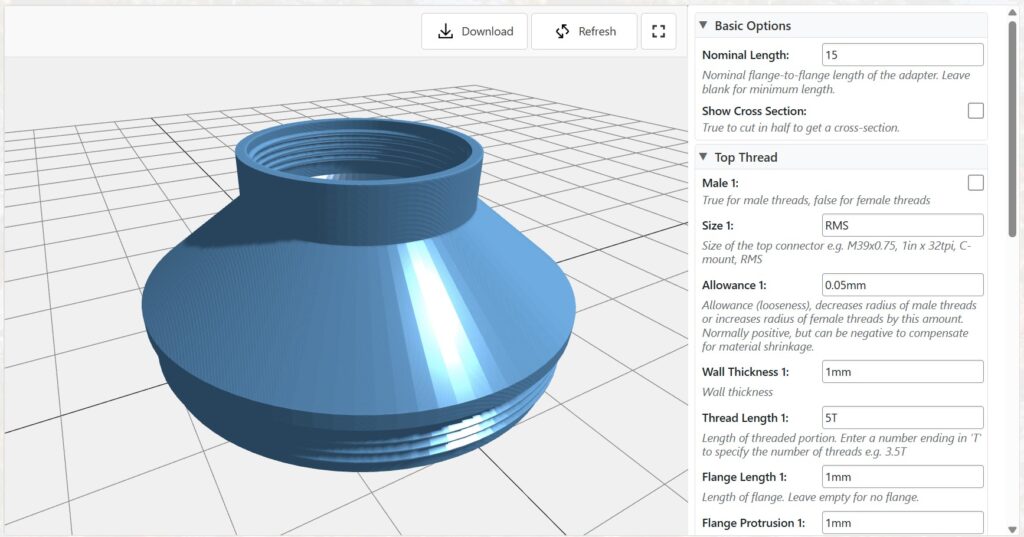Includes affiliate links that help offset our expenses at no cost to you.
Jay’s Adapt~O~Matic

The Adapt~O~Matic creates customized 3D-printable adapters for things like lenses and filters, or pretty much anything with metric or Unified threads.
Map Ruler Generator

Generates printable map rulers with custom scales.
Recommended Reading
These are some of the books we have found useful (you can just click on the links below to see them at Amazon.com):
Mycelium Running: How Mushrooms Can Help Save the World
Highly recommended! This is a fantastic book about growing and harvesting mushrooms, and about using them to restore damaged forest habitat. Lots and lots of full-color photos illustrate all aspects of mushroom biology, cultivation and the most prominent useful species. Extensive analysis of nutrition and medicinal uses, as well as culinary preparation. After reading this book we’re planning to grow a wide variety of ‘shrooms in our forest, although we’ll avoid growing any psylocybe species that could land us in prison. The book does include some of those, but mostly it’s about edible mushrooms and especially those that also have beneficial medicinal properties.
Gaia’s Garden, Second Edition: A Guide To Home-Scale Permaculture
This is the best introductory permaculture book we’ve read. If you’re new to permaculture this is the one to start with, especially considering it’s low price. It doesn’t have the depth (or price) of some of the longer tomes below but it’s a great place to start and will teach you what permaculture is all about.
Edible Forest Gardens (2 volume set)
This two-volume set is big (about 1000 pages) and pricey but worth it if you’re serious about creating a forest garden.
The printing quality is very high with lots of color photographs and illustrations in the first volume. It’s a very detailed textbook-like reference that is well-written and readable, but it’s not for you if you’re just looking for an introduction to forest gardening. We found it especially useful because it is geared largely toward the climate of the eastern half of the U.S. between USDA zones 4
and 7. It’s still relevant to other areas but it has some very valuable plant lists that are specific to this region.
Permaculture: A Designers’ Manual
This is touted as the definitive permaculture reference that started it all, and it’s worth reading. But it’s pricey and was out of print for a while, and it is often a slow read. The author sometimes belabors obvious points that aren’t worth repeating, so we had to skip ahead at times to stay awake. Other permaculture books are better written but they don’t have the depth of information that the Designers’
Manual does.
The New Create an Oasis With Greywater: Choosing, Building and Using Greywater Systems – Includes Branched Drains
This is a great book for designing systems that reuse greywater in various ways. It’s more useful in areas where water is scarce or wastewater is hard to dispose of, neither of which apply particularly to our part of Michigan. However the book does a good job of showing a wide range of options, from something as simple as redirecting a washing machine’s drain onto the garden to fully-integrated collection and distribution systems. Most likely the more complex approaches won’t be appropriate for us but the simpler ones make sense and the book does a pretty good job with them.
Root Cellaring: Natural Cold Storage of Fruits & Vegetables
A very well-written and inexpensive book on root cellaring. It shows a wide variety of cool-storage systems from the very simple and cheap to the deluxe. The sections on specific fruits and vegetables and their storage qualities are especially useful.
Four-Season Harvest: Organic Vegetables from Your Home Garden All Year Long
This isn’t a book about growing vegetables all year, but about harvesting them all year in a cold climate such as ours (the authors are from Maine). The key is to use a combination of root cellaring techniques and a greenhouse or cold frame that can sustain certain plants over the winter so that they can be grown in the fall and harvested all winter long. The authors have done a lot of research into plants that will grow in reduced light and tolerate some degree of freezing while still being harvestable when they thaw out, and they use no artificial heat sources in their greenhouse. It’s worth getting the book just for the lists of plants, many of which we had never heard of before but are widely grown in Europe.
The Not So Big House: A Blueprint for the Way We Really Live (Susanka)
The book that started a small revolution in house design. Building “not so big” does not necessarily mean building cheaper; it means building smaller and better houses that fit their inhabitants and conserve resources.
This is the place to start when considering a not-so-big design, and author Sarah Susanka has written several additional great books on the subject.
Contact Us
Spam-bots, please send all spam to: sales@BrainRight.com where it will be completely ignored.
If you are an actual human being and not trying to sell something, you can reach us by email using this address: Jay (at) BrainRight (dot) com
As an Amazon Associate I earn from qualifying purchases.